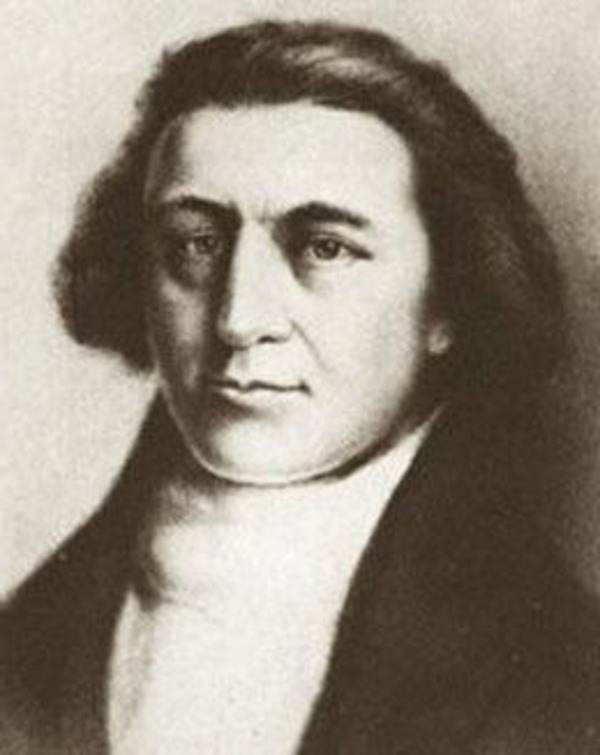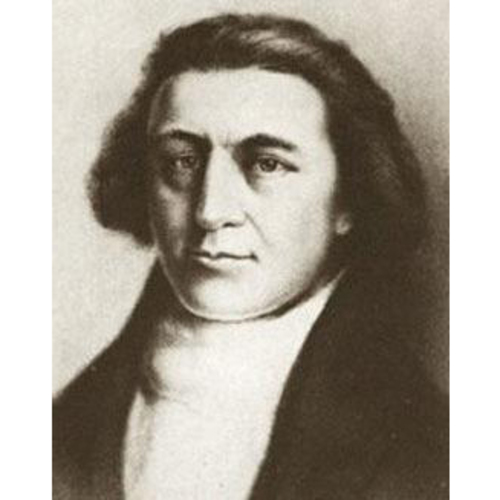
Source: Courtesy of Wikimedia Commons
GRAY, ROBERT, merchant captain, fur trader, and explorer; b. 10 May 1755 in Tiverton, R.I., son of William and Elizabeth Gray; d. in the summer of 1806, probably at sea.
Robert Gray’s widow was to state in a memorial submitted to the United States Congress in 1846 that her husband had served in the naval forces during the Revolutionary War, but no documentary – proof has been found. He first comes to notice in 1787. Shortly before this, businessmen in New England had learned that the fur of the sea otter, plentiful on the northwest coast, had fetched high prices in China when sold there by members of James Cook*’s last expedition. Eager for Chinese goods, a group of Boston merchants headed by Joseph Barrell sent to the northwest an expedition led by John Kendrick*. It consisted of the ship Columbia Rediviva, under Kendrick, and the small sloop Lady Washington, commanded by Gray.
The ships sailed from Boston on 30 Sept. 1787, but Kendrick was a dilatory commander and they were a full year on the way to Nootka Sound (B.C.). Gray arrived on 17 Sept. 1788, in time to meet John Meares, who was about to sail for the Sandwich (Hawaiian) Islands, and he witnessed the launching of Meares’s schooner North West America. Kendrick arrived on 22 September and decided it was too late to trade for furs; both ships lay idle in the sound until March 1789. Gray in the Washington then sailed on a trading cruise, ranging the coast from Juan de Fuca Strait to Bucareli Bay (Alaska), and proving the insularity of the Queen Charlotte Islands. When he returned to Nootka on 17 June he found the Columbia still at anchor, and discovered that the Spaniards under Esteban José Martínez* had taken possession of the sound. During the following month James Colnett, commanding British merchant ships owned in part by Meares, arrived with the intention of establishing a trading post. Although this objective led to a clash with Martínez, and thus to the Nootka Sound controversy, the Spanish commander did not molest Gray or Kendrick, who remained on good terms with him. On 16 July the Americans left Nootka and sailed south to Clayoquot Sound (B.C.). There Kendrick transferred the furs the Washington had collected to the Columbia, and sent the latter to China and thence back to Boston under Gray’s command. She arrived at Boston on 9 Aug. 1790, the first vessel to carry the Stars and Stripes around the world.
The venture was not a financial success, but it was clear there was a good prospect that subsequent voyages would prove profitable. American merchants, unlike their British competitors, were not hampered by the necessity of securing licences from chartered companies holding monopolies, and were unaffected by the long wars that were to plague Europe. The Columbia’s voyage initiated for New England a trading contact with the northwest coast that was to continue for 40 years, and American ships soon completely dominated the maritime fur trade.
Barrell reorganized his enterprise, in which Gray became a partner, and on 28 Sept. 1790, after a respite of only six weeks, the Columbia sailed again. Gray was a fine seaman, and under his driving command the ship reached Clayoquot Sound in little more than eight months, on 5 June 1791. The next few months were spent trading on the coast. Late in September Gray found winter quarters in the sound where he built Fort Defiance, apparently at present-day Lemmens Inlet in Meares Island. The small sloop Adventure was completed there and launched in February 1792 [see Robert Haswell]; she was sold to the Spaniards at the end of the trading season.
Relations with the Indians had been reasonably good, but Gray’s ship had been threatened several times, and in January a plot by Wikinanish* to seize the Columbia and kill her crew was discovered. Gray was not a man to be trifled with. On 27 Mach, just before the ship left Clayoquot Sound, he retaliated by ordering the burning of Opitsat, a large Nootka village of some 200 houses. The order was carried out by one of the mates, John Boit, who confesses in his journal that he was “greived to think Capt. Gray shou’d let his passions go so far. . . . This fine Village, the Work of Ages, was in a short time totally destroy’d.”
Sailing southward, Gray met George Vancouver*’s ships on 29 April, and on 7 May discovered and named Grays Harbor (Wash.). On the 11th came the climax of his career, the discovery of the Columbia River, which he named after his ship. Others had suspected the existence of the river, but Gray was the first who dared to take his ship through the forbidding breakers and shoals that stretched across its mouth. By so doing he gave the United States one of its strongest claims to the Oregon country.
By 24 July Gray was back in Nootka Sound, where Juan Francisco de la Bodega* y Quadra, the new Spanish commandant, was awaiting Vancouver’s arrival to negotiate a settlement of the rival claims to the sound. From Gray and Joseph Ingraham (second mate of the Columbia in 1789) Bodega secured a joint statement supporting his contention that Meares’s claims against the Spaniards were unfounded. After a brief trading cruise Gray returned to Nootka Sound in September, when he reported to Vancouver his discovery of the Columbia and gave him a rough sketch of its estuary. The Columbia left the coast on 3 Oct. 1792 and returned to Boston by way of China on 26 July 1793.
On 3 February the following year Gray married Martha Atkins; they had four daughters and a son, Robert Don Quadra, who died in childhood. Except in 1799–1800, when trouble developed with France and he was briefly in command of the privateer Lucy, Gray spent his late years in coasting ships sailing out of Boston. The exact date of his death is not known, but he is believed to have died of yellow fever in 1806 while on a voyage to Charleston, S.C.
[The Mass. Hist. Soc. (Boston) holds the logs of Robert Haswell, an officer on both voyages: “A voyage round the world onboard the ship Columbia-Rediviva and sloop Washington,” [1787–89], and “A voyage on discoveries in the ship Columbia Rediviva,” [1791–93]. It also holds John Boit’s log of the second voyage, “Remarks on the ship Columbia’s voyage from Boston (on a voyage round the Globe), 1790–1793,” and an account of it by John Box Hoskins, supercargo, “The narrative of a voyage to the north west coast of America and China on trade and discoveries performed in the ship Columbia Rediviva, 1790, 1791, 1792 and 1793.” The ship’s official logs are lost, but Robert Greenhow secured an extract recording the discovery of Grays Harbor and the Columbia River and printed it in The history of Oregon and California, and the other territories on the northwest coast of North America . . . (Boston, 1844; repr. Los Angeles, 1970), 434–36. These logs and journals, together with miscellaneous letters and other papers, are included in Voyages of the “Columbia” to the northwest coast, 1787–1790 and 1790–1793, ed. F. W. Howay ([Boston], 1941; repr. Amsterdam and New York, [1969]), although Haswell’s log of the second voyage comes from the incomplete transcript held by the Bancroft Library, Univ. of California (Berkeley), the only text available at the time.
Additional details appear in the following: “Captains Gray and Kendrick; the Barrell letters,” ed. F. W. Howay, Wash. Hist. Quarterly (Seattle), 12 (1921): 243–71. “Letters relating to the second voyage of the ‘Columbia,’” ed. F. W. Howay, Oreg. Hist. Soc., Quarterly (Eugene), 24 (1923): 132–52. Jack Fry, “Fort Defiance: relics discovered last summer may establish the wintering place in 1791–2 of Captain Robert Gray,” Beaver, outfit 298 (summer 1967): 18–21. F. W. Howay, “Voyages of Kendrick and Gray in 1787–90,” Oreg. Hist. Quarterly, 30 (1929): 89–94. F. W. Howay and Albert Matthews, “Some notes upon Captain Robert Gray,” Wash. Hist. Quarterly, 21 (1930): 8–12. E. S. Meany, “The widow of Captain Robert Gray,” Wash. Hist. Quarterly, 20 (1929): 192–95. D. H. Mitchell, “The investigation of Fort Defiance: verifications of the site,” BC Studies (Vancouver), no.4 (spring 1970): 3–20. S. E. Morison, “The Columbia’s winter quarters of 1791–92 located,” Oreg. Hist. Quarterly (Salem), 39 (1938): 3–7. w.k.l.]
Cite This Article
W. Kaye Lamb, “GRAY, ROBERT (1755-1806),” in Dictionary of Canadian Biography, vol. 5, University of Toronto/Université Laval, 2003–, accessed December 13, 2025, https://www.biographi.ca/en/bio/gray_robert_1755_1806_5E.html.
The citation above shows the format for footnotes and endnotes according to the Chicago manual of style (16th edition). Information to be used in other citation formats:
| Permalink: | https://www.biographi.ca/en/bio/gray_robert_1755_1806_5E.html |
| Author of Article: | W. Kaye Lamb |
| Title of Article: | GRAY, ROBERT (1755-1806) |
| Publication Name: | Dictionary of Canadian Biography, vol. 5 |
| Publisher: | University of Toronto/Université Laval |
| Year of publication: | 1983 |
| Year of revision: | 1983 |
| Access Date: | December 13, 2025 |



